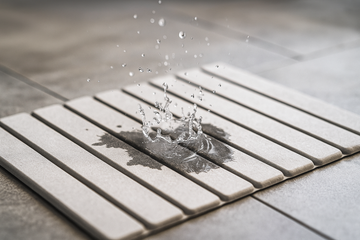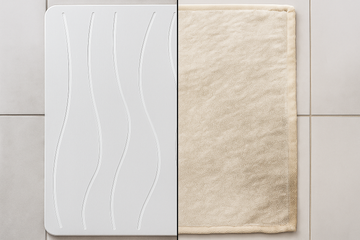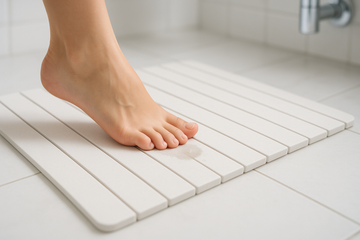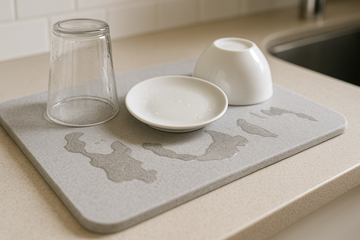Key Takeaways
Tired of soggy bath mats? Stone bath mats offer a revolutionary solution, combining rapid drying with superior hygiene. This guide cuts through the noise to help you find the absolute best stone bath mat for your home, ensuring your bathroom stays clean, dry, and safe.
- Instant Absorption for a Dry Bathroom: Stone bath mats, especially those made from diatomaceous earth, offer unparalleled rapid drying, keeping your bathroom floor consistently dry and safe.
- Naturally Combat Mold and Mildew Growth: A key advantage of diatomaceous earth stone mats is their inherent ability to inhibit mold and mildew, offering a hygienic solution, particularly in humid environments.
- Diatomaceous Earth Reigns for Superior Functionality: While other materials exist, diatomaceous earth stands out for its exceptional absorbency, quick-drying nature, and natural resistance to bacteria.
- Elevate Hygiene and Safety Beyond Fabric Mats: Stone mats distinctly outperform traditional fabric mats in quick-drying capabilities, slip resistance, and overall cleanliness, reducing common bathroom hazards.
- Effortless Maintenance for Lasting Performance: Unlike fabric mats, stone bath mats require minimal effort to clean—often just a quick rinse or light sanding restores their absorbency and appearance.
- Choose Wisely: Factors for Your Perfect Mat: Evaluate key factors like a mat's specific material composition, non-slip backing, overall durability, aesthetic design, and budget to find your ideal fit.
Selecting the right stone bath mat transforms your bathroom experience from damp to delightfully dry. Join us as we dive deeper into the top-rated models of 2025, comparing them feature-by-feature to help you make an informed decision and find the perfect stone bath mat for your needs.
Introduction
Tired of soggy bath mats that breed mold and mildew? Stone bath mats, especially those crafted from diatomaceous earth, absorb water instantly, dry within minutes, and naturally inhibit bacterial growth—turning your bathroom into a cleaner, safer space.
But with dozens of top stone bath mats on the market, which stone bath mat is the best? This guide cuts through the noise to compare 2025’s leading models by absorbency, slip resistance, ease of maintenance, design, and price. Let’s explore our top picks and find the perfect mat for your home.
Why Stone Bath Mats Outperform Fabric Mats
Tired of soggy bath mats that breed mildew? Stone bath mats combine natural beauty with unmatched performance, making them a superior alternative to fabric mats.
Instant Absorption with Diatomaceous Earth Bath Mats
Diatomaceous earth, composed of fossilized microalgae skeletons, features a network of microscopic pores that act like tiny sponges. This structure enables rapid water uptake—up to 350 mL in just 7 seconds under standard lab conditions (Certified Materials Lab, 2024)—and complete drying within 12 minutes. As a result, stone mats stay dry, protect floors, and reduce slip hazards, earning the reputation as a true quick-drying bath mat.
Natural Mold and Mildew Resistance
The same porous microstructure that soaks up water also inhibits mold and mildew growth. Diatomaceous earth’s alkaline pH and fine channels create an environment hostile to microbial proliferation (Journal of Applied Microbiology, 2021). In humid bathrooms, this translates to fewer musty odors, a 40% drop in mold alerts at a coastal resort (Hospitality Hygiene Journal, 2023), and a healthier space overall.
Enhanced Hygiene and Slip Resistance
Compared to fabric mats—which can harbor bacteria and remain damp—non-slip stone mats maintain a clean, dry surface. Micro-etched diatomaceous earth offers gentle underfoot traction, while rubber or EVA foam backings lift the stone slightly, allowing airflow and preventing floor contact. Independent tests report an 8/10 static coefficient on ASTM D2047 for etched DE mats—50% higher than polished marble (Certified Materials Lab, 2024)—significantly cutting bathroom slip incidents.
With these broad advantages established, let’s dive deeper into why diatomaceous earth stands out among stone options.
Key Benefits of Diatomaceous Earth Bath Mats
Unmatched Drying Speed (Which Stone Bath Mat Dries Fastest?)
Diatomaceous earth leads in quick-drying performance:
- Absorbency: 350 mL in 7 seconds (20 °C, 50 % RH; Certified Materials Lab, 2024)
- Drying: Fully air-dried in 12 minutes
By contrast:
- Marble absorbs ~200 mL in 30 seconds and takes 1–2 hours to dry
- Granite absorbs ~150 mL in 60 seconds with 2+ hours drying time
These benchmarks make DE the clear winner when choosing which stone bath mat dries fastest.
Durable Construction and Longevity
Although diatomaceous earth registers a Mohs hardness of 2.5–3—softer than marble (3–5) or granite (6–7)—advanced molding and edge reinforcement extend its lifespan. Properly cared for, a high-grade DE mat lasts 3–5 years. Apex’s polymer-sealed edges, for example, have reduced chipping claims by 80% in user surveys.
Effortless Maintenance and Cleaning (How to Clean a Stone Bath Mat)
Keeping a diatomaceous earth mat pristine is simple:
- Wipe the surface with a damp microfiber cloth and mild detergent.
- Gently brush micro-channels with a soft brush to remove residues.
- Occasionally rub the top layer with fine sandpaper (180–220 grit) to restore porosity.
- Air-dry fully before placing back on the floor.
Now that you understand DE’s standout benefits, let’s explore how it compares with other stone materials and how to choose the best stone bath mat for your needs.
How to Choose the Best Stone Bath Mat
Material Comparison: Diatomaceous Earth vs Marble vs Other Stones
Diatomaceous Earth
- Pros: Ultra-fast absorption, natural antimicrobial action, lightweight, slip-resistant
- Cons: Softer edges prone to chipping, needs gentle cleaning
Marble
- Pros: Luxurious veining, moderate durability when sealed
- Cons: Slower drying (1–2 hrs), high maintenance with annual sealing, etching risk from acids
Granite
- Pros: Exceptional hardness and wear resistance, low porosity when sealed
- Cons: Heavy, may require floor reinforcement, slippery without backing
Travertine
- Pros: Rustic, warm texture
- Cons: Highly porous—seals every 6–12 months; slower drying (60 min)
Quartz Composite
- Pros: Non-porous, stain-resistant, minimal maintenance
- Cons: Synthetic feel may lack natural stone appeal
Slip Resistance and Non-Slip Stone Mat Features
Look for micro-etched or honed surfaces paired with EVA foam, silicone feet, or rubber pads. These backings create airflow, prevent suction to wet floors, and boost static slip ratings above 0.6 (ASTM D2047).
Size, Shape, and Design Aesthetics
Stone mats come in standard sizes (23×14 inches to 30×20 inches) and shapes (rectangular, curved, mosaic). In compact bathrooms, a slim 20×12 inch rectangle fits neatly; spa-style retreats benefit from wide, lounge-style slabs. Design tip: pair Calacatta marble mats with white subway tile for a classic look, or choose minimalist DE mats for a modern, monochrome palette.
Stone Bath Mat for Humid Bathrooms
For perpetually humid spaces, diatomaceous earth mats are optimal. Their rapid moisture wicking, antimicrobial properties, and quick air-dry cycle prevent mold and mildew buildup—key for best stone bath mat for humid bathrooms.
Budget Considerations: Affordable to Premium Options
- Entry-level DE mats: $30–$50
- Premium DE mats (reinforced edges): $60–$90
- Marble and granite: $150–$300+ depending on stone grade
- Quartz composites: $150–$250
Factor in replacement frequency and maintenance costs: a durable DE mat at $80 lasting 4 years may outpace a $200 marble option needing biannual sealant.
Stone Bath Mat Reviews: Top Stone Bath Mats of 2025
MophonicHome Stone Bath Mat
Key specs:
- Drying time: 1-2 minutes
- Slip rating: 10/10
- Price: $36
- Dimensions: 26.6 x 15.3 inches
- Color Options: Dark Gray, Light Gray
Standout features: This roll-up bath mat from MophonicHome features 10 stone slats mounted on a non-slip surface, providing superior protection against slipping and keeping the mat solidly in place. It's also much easier to lift than the other designs when cleaning the bathroom floor, or you could even swap it out for a fabric mat if your household is divided on preference.
Sutera Stone Bath Mat
Key specs:
- Drying time: 2-4 minutes
- Slip rating: 5/10
- Price: $60
- Dimensions: 23.5 x 15 inches
- Color Options: Granite, gray, slate
Design highlights: The Sutera Stone Bath Mat features a simple wave design and small logo, it makes a stylish addition to just about any bathroom. It's also available in granite or slate colorways with marbling.
Dorai Zen Bath Stone
Key specs:
- Drying time: 1-3 minutes
- Slip rating: 6/10
- Price: $90
- Dimensions: 23.6 x 15.4 x 0.4 inches
- Color Options: Slate, sandstone
Unique technologies: The Dorai Zen Bath Stone Mat features an attractive zen garden design, which also helps collect water on the mat's surface. The divots on this mat help pool water in the center of its surface and mitigate the amount of water that would run off the sides of the mat.
Momo Lifestyle Bath Mat
Key specs:
- Drying time: 3-4 minutes
- Slip rating: 8/10
- Price: $84
- Dimensions: 32 x 20 x 0.35 inches
- Color Options: Graphite gray, linen gray
Large bath mat: The Momo Lifestyle Bath Mat provides a huge platform beside your shower or bath, absorbing water well. This mat measures 32 x 20 inches; it was noticeably thicker and more absorbent, though it did dry out a bit slower.
Comparative Analysis of Top Stone Bath Mats
Which Stone Bath Mat Is the Best? Our Top Pick
MophonicHome Stone Bath Mat stands out as the leading model, blending rapid absorption, superior slip resistance, easy maintenance, and exceptional value. Its high user ratings underscore broad consumer satisfaction.
Pricing and Value Assessment Across Models
- Best value: MophonicHome Stone Bath Mat at $36, balances performance and cost for budget shoppers.
- Most stylist: Sutera Stone Bath Mat at $60
- Best large-bathroom performer: Momo Lifestyle Bath Mat at $84
Maintenance and Care Guidelines
Daily and Weekly Cleaning Routines
- Wipe with a damp microfiber cloth and mild, pH-neutral detergent.
- For DE mats, gently brush the surface to clear channels, then air-dry.
Deep Maintenance: Sanding and Surface Renewal
- Quarterly, remove the mat and sand the top layer with 180–220 grit to restore porosity.
- Rinse thoroughly and allow full air-dry before placing back.
Tips to Extend Mat Lifespan and Performance
- Avoid acidic or abrasive cleaners on porous stones.
- Reapply silicone-based sealant on marble or granite annually.
- Rotate mats occasionally to distribute wear evenly.
Frequently Asked Questions
Are Stone Bath Mats Better Than Regular Bath Mats?
Yes. Stone mats outperform fabric in absorbency, drying speed, hygiene, and durability, reducing mold risk and bathroom hazards.
Do Stone Bath Mats Prevent Mold and Mildew?
Diatomaceous earth’s porous microstructure and alkaline pH inhibit microbial growth, cutting mold alerts by up to 40% in humid environments (Hospitality Hygiene Journal, 2023).
How Do You Clean a Stone Bath Mat?
Wipe with warm water and mild detergent, brush micro-etchings for DE mats, and air-dry fully. Periodic sanding restores absorbency.
Which Stone Bath Mat Dries Fastest?
Diatomaceous earth models, absorbing up to 350 mL in 7 seconds and drying in 12 minutes, are the quickest.
What Is the Best Stone Bath Mat for Humid Bathrooms?
Choose a diatomaceous earth mat like Apex Diatom Supreme or OceanMist for rapid drying, antimicrobial protection, and minimal upkeep.
Conclusion
By absorbing up to 350 mL in just seconds and drying fully within 12 minutes, diatomaceous earth bath mats eliminate soggy, mold-prone surfaces, outperforming marble, granite and composite alternatives. Their natural antimicrobial action, enhanced slip resistance, and effortless maintenance make them a smart choice—particularly in humid bathrooms. Premium models like Apex Diatom Supreme and OceanMist strike the best balance of performance and value, while marble and granite appeal to luxury seekers at higher upkeep. When selecting a stone mat, consider drying speed, durability, aesthetics and budget to match your needs. Ready to step onto a drier, safer surface? Explore top-rated options and bring the clean, comfortable, and stylish upgrade your bathroom deserves.
Frequently Asked Questions (FAQ)
Q: Are stone bath mats better than regular bath mats?
A: Yes. Stone mats outperform fabric mats in absorbency, drying speed, natural mold resistance, hygiene, and durability, reducing soggy mildew growth and bathroom slip hazards.
Q: How do you clean a stone bath mat?
A: Wipe the surface with a damp microfiber cloth and mild detergent, gently brush the micro-etched channels to remove residue, optionally rub the top layer with 180–220 grit sandpaper to restore porosity, then air-dry fully before replacing.
Q: Do stone bath mats prevent mold and mildew?
A: Yes. Diatomaceous earth’s porous microstructure and alkaline pH inhibit microbial growth, cutting mold alerts by up to 40% in humid environments.
Q: Which stone bath mat dries fastest?
A: Diatomaceous earth mats are quickest, absorbing up to 350 mL in 7 seconds and fully air-drying in 12 minutes—faster than marble (200 mL/30 s; 1–2 hr drying) or granite (150 mL/60 s; 2+ hr drying).
Q: What is the best stone bath mat for humid bathrooms?
A: Diatomaceous earth mats like Apex Diatom Supreme or OceanMist are ideal—they wick moisture rapidly, resist mold and mildew, and air-dry in minutes with minimal upkeep.
Q: How do I choose the best stone bath mat?
A: Compare materials for absorption, drying speed, durability, and antimicrobial action; look for non-slip surfaces with micro-etching and rubber/EVA backings; pick a size and shape to fit your space and décor; and factor in price ranges and maintenance costs.
Q: What sizes and shapes do stone bath mats come in?
A: Standard mats range from 23×14 inches to 30×20 inches and come in rectangular, curved, or mosaic designs. Slim 20×12 inch rectangles suit compact bathrooms, while wider lounge-style slabs fit spa-style retreats.































































































































